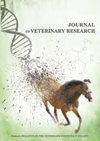牛奶、羊奶和绵羊奶中全氟烷基物质的含量——膳食摄入量及风险评估
IF 1.3
3区 农林科学
Q2 VETERINARY SCIENCES
引用次数: 0
摘要
摘要简介对奶牛、山羊和绵羊的牛奶进行了14种全氟烷基物质(PFASs)的含量分析。材料和方法共从波兰不同地区收集了73份牛奶样本,分别来自奶牛(n = 38)、山羊(n = 20)和绵羊(n = 15)。采用液相色谱-串联质谱法(LC-MS/MS)测定分析物浓度。结果全氟辛烷磺酸(PFOS)、全氟辛酸、全氟壬烷酸和全氟己磺酸4种PFAS浓度下限之和(∑4 PFASs)以绵羊最高(0.0055 μg/kg),山羊最低(0.0046 μg/kg),牛奶最低(0.0008 μg/kg)。统计数据显示,山羊奶和绵羊奶的污染程度明显高于牛奶。所有样品均未超过欧盟委员会建议(EU) 2022/1431设定的指示值,甚至最大检测浓度也低了一个数量级。最常检测到的是线性全氟辛烷磺酸,分别在33%、76%和93%的牛奶、山羊和绵羊奶样本中发现。根据平均上限∑4 PFAS浓度和平均牛奶消费量,估计儿童的∑4 PFAS摄入量在0.153 ~ 0.266 ng/kg体重(b.w.)之间,成人的摄入量在0.050 ~ 0.88 ng/kg体重(b.w.)之间,这表明暴露非常低,仅为儿童可耐受周摄入量(TWI)的7%和成人可耐受周摄入量的2%。结论:无论哪种牛奶,通过波兰牛奶摄入的全氟磺酸对成人或儿童的全氟磺酸总摄入量都没有显著影响。本文章由计算机程序翻译,如有差异,请以英文原文为准。
Occurrence of perfluoroalkyl substances in cow’s, goat’s and sheep’s milk – dietary intake and risk assessment
Abstract Introduction Milk from cows, goats and sheep was analysed in terms of content of fourteen perfluoroalkyl substances (PFASs). Material and Methods Altogether, 73 milk samples from cows (n = 38), goats (n = 20) and sheep (n = 15) were collected from various regions of Poland. Concentrations of analytes were determined using liquid chromatography–tandem mass spectrometry (LC-MS/MS). Results The lower-bound sum of four PFAS (∑4 PFASs) concentrations (perfluorooctanesulfonic acid (PFOS), perfluorooctanoic acid, perfluorononanoic acid and perfluorohexanesulfonic acid) were highest in sheep’s (0.0055 μg/kg), lower in goat’s (0.0046 μg/kg), and lowest in cow’s milk (0.0008 μg/kg). Goat’s and sheep’s milk was statistically significantly more contaminated than cow’s milk. None of the samples exceeded the indicative values set by Commission Recommendation (EU) 2022/1431, and even the maximum detected concentrations were an order of magnitude lower. The most frequently detected was linear PFOS, which was found in 33%, 76% and 93% of cow’s, goat’s and sheep’s milk samples, respectively. Based on mean upper-bound ∑4 PFAS concentrations and average milk consumption, the estimated intake of ∑4 PFASs ranged from 0.153 to 0.266 ng/kg body weight (b.w.) for children and from 0.050 to 0.88 ng/kg b.w. for adults, which indicates that exposure is very low and is merely <7% of the tolerable weekly intake (TWI) for children and <2% of the TWI for adults. Conclusion Regardless of the milk type, the intake of PFASs via consumption of Polish milk does not contribute significantly to the overall PFAS intake of either adults or children.
求助全文
通过发布文献求助,成功后即可免费获取论文全文。
去求助
来源期刊

Journal of Veterinary Research
Veterinary-General Veterinary
CiteScore
0.90
自引率
5.60%
发文量
58
审稿时长
18 weeks
期刊介绍:
Journal of Veterinary Research (formerly Bulletin of the Veterinary Institute in Pulawy) is a quarterly that publishes original papers, review articles and short communications on bacteriology, virology, parasitology, immunology, molecular biology, pathology, toxicology, pharmacology, and biochemistry. The main emphasis is, however, on infectious diseases of animals, food safety and public health, and clinical sciences.
 求助内容:
求助内容: 应助结果提醒方式:
应助结果提醒方式:


